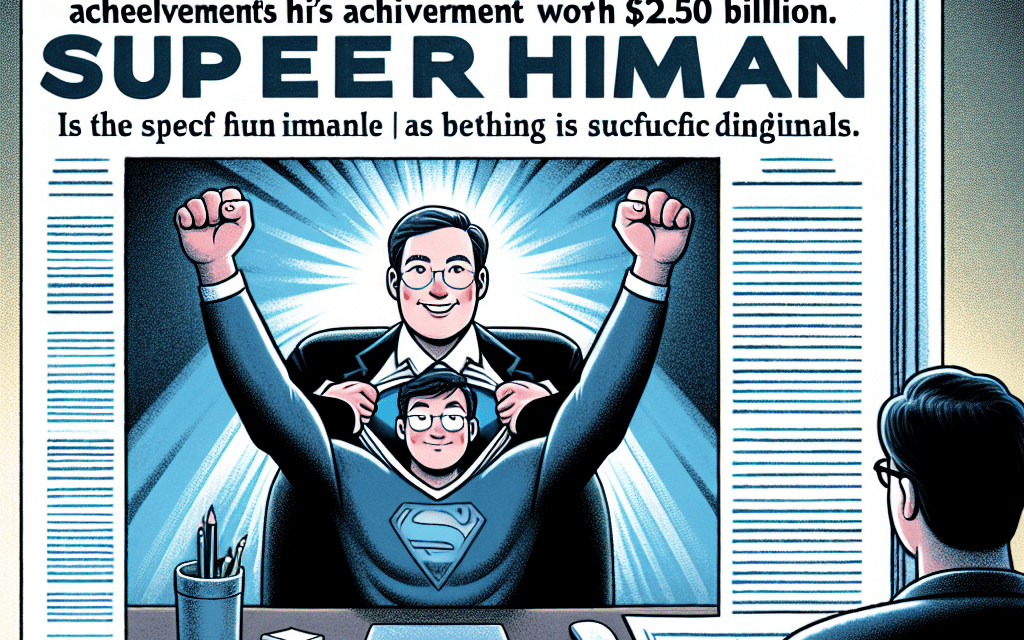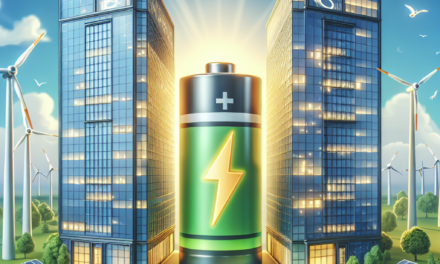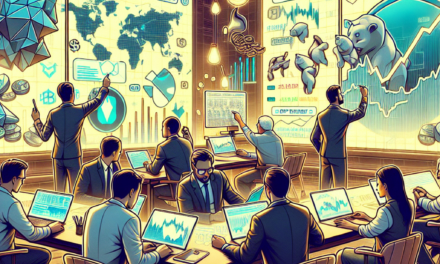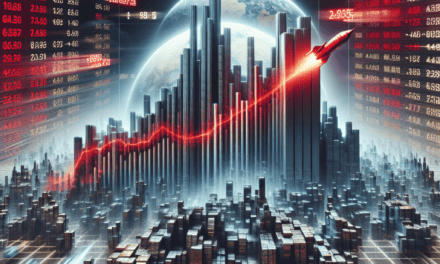“Jensen Huang Hails Elon Musk’s $2.5 Billion Feat as a Leap Beyond Human Limits.”
Introduction
Nvidia’s CEO, Jensen Huang, has long been a prominent figure in the tech industry, known for his visionary leadership and pioneering work in graphics processing and artificial intelligence. His admiration for Elon Musk’s achievements, particularly the recent $2.5 billion milestone, underscores the extraordinary nature of Musk’s accomplishments. Huang views Musk’s ability to consistently push the boundaries of technology and innovation as nothing short of superhuman. This perspective is rooted in Musk’s relentless pursuit of ambitious goals, from revolutionizing the automotive industry with Tesla to advancing space exploration through SpaceX. Huang’s recognition of Musk’s achievements highlights the profound impact that visionary leaders can have on shaping the future of technology and industry.
Understanding the Impact of Elon Musk’s $2.5 Billion Achievement
In the ever-evolving landscape of technology and innovation, few figures stand out as prominently as Elon Musk. His recent achievement of raising $2.5 billion has captured the attention of industry leaders and observers alike, including Nvidia’s CEO, Jensen Huang. Huang, a visionary in his own right, has described Musk’s accomplishment as “superhuman,” a term that underscores the magnitude and impact of this financial milestone. To understand why Huang attributes such a remarkable label to Musk’s achievement, it is essential to delve into the broader implications of this financial feat and its potential to reshape industries.
Elon Musk’s ability to secure $2.5 billion is not merely a testament to his prowess in fundraising but also a reflection of his visionary approach to business and technology. This substantial sum is poised to fuel Musk’s ambitious projects, which span across various sectors, including space exploration, electric vehicles, and renewable energy. Each of these areas holds the potential to drive significant advancements in technology and sustainability, aligning with global efforts to address pressing challenges such as climate change and resource scarcity.
Moreover, Musk’s achievement is emblematic of his unique capacity to inspire confidence among investors. His track record of turning seemingly audacious ideas into reality, as evidenced by the success of companies like Tesla and SpaceX, has cultivated a sense of trust and optimism in his ventures. This trust is crucial in an era where technological innovation often requires substantial upfront investment and a willingness to embrace risk. By securing such a significant amount of funding, Musk not only reinforces his credibility but also sets a precedent for other entrepreneurs seeking to push the boundaries of what is possible.
Jensen Huang’s characterization of Musk’s achievement as “superhuman” also highlights the extraordinary nature of the challenges Musk is willing to tackle. The projects that stand to benefit from this funding are not merely incremental improvements on existing technologies; they represent bold leaps into the future. For instance, SpaceX’s mission to colonize Mars and Tesla’s commitment to accelerating the world’s transition to sustainable energy are endeavors that require not only financial resources but also a visionary mindset and an unwavering determination to overcome obstacles.
Furthermore, the ripple effects of Musk’s $2.5 billion achievement extend beyond his own ventures. It serves as a catalyst for innovation across the technology sector, inspiring other companies and entrepreneurs to pursue ambitious goals. The infusion of capital into Musk’s projects is likely to spur advancements in related fields, such as artificial intelligence, battery technology, and autonomous systems. This interconnected web of innovation has the potential to drive economic growth and create new opportunities for collaboration and development.
In conclusion, Elon Musk’s $2.5 billion achievement is a testament to his visionary leadership and his ability to galvanize support for transformative projects. Jensen Huang’s description of this accomplishment as “superhuman” underscores the extraordinary impact it is poised to have on technology and society. As Musk continues to push the boundaries of innovation, his endeavors serve as a beacon of inspiration for those who dare to dream big and strive for a future that transcends the limitations of the present. Through this lens, Musk’s achievement is not just a financial milestone but a pivotal moment in the ongoing narrative of technological progress.
Jensen Huang’s Perspective on Superhuman Achievements
Jensen Huang, the visionary CEO of Nvidia, has long been a prominent figure in the tech industry, known for his insightful perspectives on innovation and leadership. Recently, Huang has turned his attention to Elon Musk, the enigmatic entrepreneur behind companies like Tesla and SpaceX, and his latest achievement—a staggering $2.5 billion milestone. Huang’s admiration for Musk’s accomplishment is not merely rooted in the financial success it represents but rather in the superhuman qualities that he believes Musk embodies. To understand Huang’s perspective, it is essential to delve into the characteristics that define superhuman achievements and how Musk exemplifies them.
Firstly, Huang emphasizes the relentless pursuit of innovation as a hallmark of superhuman achievements. Musk’s ventures are not just about creating successful businesses; they are about pushing the boundaries of what is possible. Whether it is revolutionizing the automotive industry with electric vehicles or aiming to colonize Mars, Musk’s vision extends far beyond conventional goals. Huang sees this relentless drive to innovate as a key factor that sets Musk apart, likening it to a superhuman ability to envision and execute ideas that others might deem impossible.
Moreover, Huang highlights the importance of resilience in achieving superhuman feats. Musk’s journey has been fraught with challenges, from production delays at Tesla to the technical complexities of launching reusable rockets with SpaceX. Yet, Musk’s ability to persevere through setbacks and continue striving towards his goals is a testament to his resilience. Huang believes that this unwavering determination is a crucial component of superhuman achievements, as it enables individuals to overcome obstacles that would deter most others.
In addition to innovation and resilience, Huang points to Musk’s capacity for strategic thinking as another superhuman trait. Musk’s ability to navigate complex industries and anticipate future trends has been instrumental in his success. For instance, his early recognition of the potential for electric vehicles and renewable energy has positioned Tesla as a leader in the automotive industry. Similarly, his foresight in developing SpaceX’s reusable rocket technology has revolutionized space travel. Huang argues that this strategic acumen is akin to a superhuman ability to see the bigger picture and make decisions that have far-reaching implications.
Furthermore, Huang acknowledges the role of leadership in achieving superhuman accomplishments. Musk’s leadership style, characterized by a hands-on approach and a willingness to take risks, has inspired his teams to pursue ambitious goals. Huang notes that Musk’s ability to galvanize his workforce and foster a culture of innovation is a testament to his exceptional leadership skills. This ability to inspire and lead others towards a shared vision is, in Huang’s view, a defining feature of superhuman achievements.
In conclusion, Jensen Huang’s perspective on Elon Musk’s $2.5 billion achievement is rooted in the belief that it exemplifies superhuman qualities. Through his relentless pursuit of innovation, resilience in the face of adversity, strategic thinking, and exceptional leadership, Musk has achieved feats that transcend ordinary accomplishments. Huang’s admiration for Musk is not just about the financial success he has attained but rather the extraordinary qualities that have enabled him to reach such heights. As the tech industry continues to evolve, Huang’s insights into what constitutes superhuman achievements offer valuable lessons for aspiring innovators and leaders alike.
The Role of Innovation in Musk’s Success
In the ever-evolving landscape of technology and innovation, few figures stand out as prominently as Elon Musk. His ventures, ranging from electric vehicles to space exploration, have consistently pushed the boundaries of what is possible. Recently, Nvidia’s CEO, Jensen Huang, lauded Musk’s achievements, particularly highlighting a $2.5 billion milestone, as “superhuman.” This accolade from Huang, a visionary in his own right, underscores the pivotal role that innovation plays in Musk’s success.
To understand why Huang attributes such a remarkable term to Musk’s accomplishments, it is essential to delve into the nature of innovation itself. Innovation is not merely about creating something new; it is about transforming ideas into tangible solutions that address real-world problems. Musk’s approach to innovation is characterized by a relentless pursuit of ambitious goals, often in industries that have long been resistant to change. For instance, Tesla’s impact on the automotive industry is a testament to Musk’s ability to innovate. By championing electric vehicles, Musk has not only disrupted traditional automotive manufacturing but also accelerated the global shift towards sustainable energy.
Moreover, Musk’s ventures are often marked by a willingness to take risks that others might deem insurmountable. This risk-taking is a crucial component of innovation, as it allows for the exploration of uncharted territories. SpaceX, another of Musk’s groundbreaking companies, exemplifies this principle. By developing reusable rockets, SpaceX has significantly reduced the cost of space travel, making it more accessible and sustainable. This achievement has not only revitalized interest in space exploration but has also set new standards for the industry.
Transitioning from the realm of space to the digital frontier, Musk’s endeavors with Neuralink and OpenAI further illustrate his innovative spirit. These projects aim to bridge the gap between human intelligence and artificial intelligence, exploring the potential for symbiotic relationships between humans and machines. Such initiatives highlight Musk’s forward-thinking approach, as he seeks to address future challenges that may arise from the rapid advancement of technology.
Jensen Huang’s recognition of Musk’s $2.5 billion achievement as “superhuman” is also a reflection of the broader impact that Musk’s innovations have on society. By tackling some of the most pressing issues of our time, such as climate change and sustainable energy, Musk’s work resonates with a global audience. His ability to inspire and mobilize resources towards these causes is a testament to the transformative power of innovation.
Furthermore, Musk’s success is not solely attributed to his technical prowess but also to his visionary leadership. He has cultivated a culture of innovation within his companies, empowering teams to think creatively and challenge the status quo. This environment fosters continuous improvement and adaptation, which are essential for sustaining long-term success in any industry.
In conclusion, the superhuman label attributed to Elon Musk by Jensen Huang is a recognition of the profound impact that innovation has had on Musk’s achievements. Through his ventures, Musk has demonstrated that innovation is not just about technological advancement but also about addressing societal challenges and inspiring change. As we look to the future, the role of innovation in shaping our world will undoubtedly continue to be influenced by pioneers like Musk, who dare to dream big and redefine the limits of possibility.
Comparing Leadership Styles: Huang vs. Musk
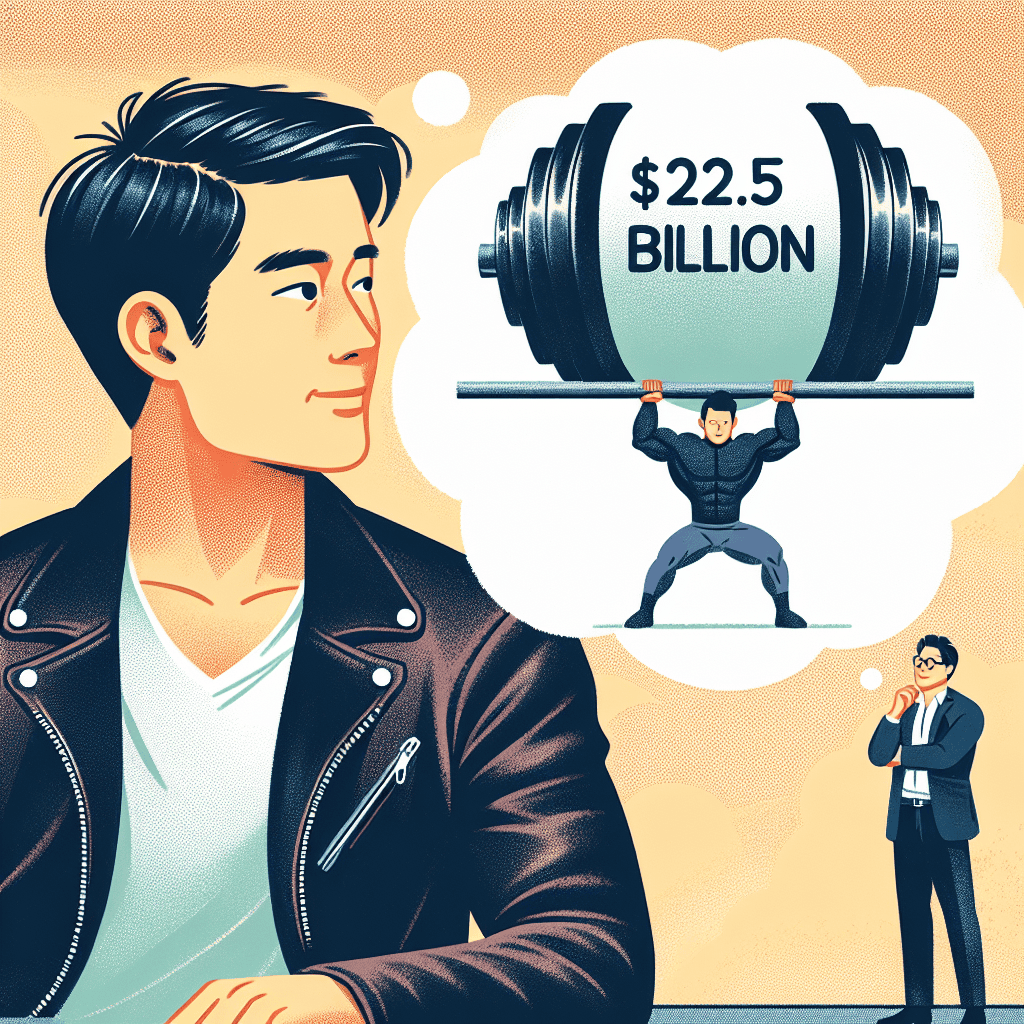
In the realm of technology and innovation, few figures stand as prominently as Nvidia’s Jensen Huang and Tesla’s Elon Musk. Both leaders have carved out significant niches in their respective industries, yet their leadership styles and approaches to business present a fascinating study in contrasts. Recently, Jensen Huang made headlines by describing Elon Musk’s $2.5 billion achievement as “superhuman,” a statement that invites a deeper exploration of what sets these two visionaries apart and what they might admire in each other.
Jensen Huang, co-founder and CEO of Nvidia, is renowned for his methodical and strategic approach to leadership. Under his guidance, Nvidia has transformed from a graphics card company into a powerhouse in artificial intelligence and high-performance computing. Huang’s leadership style is characterized by a focus on long-term vision, meticulous planning, and a deep understanding of technological trends. He is known for fostering a collaborative environment where innovation thrives, encouraging his team to push the boundaries of what is possible while maintaining a steady course toward the company’s overarching goals.
In contrast, Elon Musk, the CEO of Tesla and SpaceX, is often seen as a maverick in the business world. His leadership style is marked by bold, sometimes audacious, decision-making and an unyielding drive to achieve seemingly impossible goals. Musk’s ventures into electric vehicles, space exploration, and renewable energy have not only disrupted industries but have also redefined what is achievable within them. His ability to inspire and mobilize resources quickly is a testament to his charismatic leadership and relentless pursuit of innovation.
Despite their differing styles, both leaders share a common trait: an unwavering commitment to pushing the boundaries of technology. This shared vision is perhaps why Jensen Huang regards Musk’s $2.5 billion achievement as superhuman. Musk’s ability to amass such a fortune through ventures that were once considered speculative underscores his exceptional capacity to turn visionary ideas into reality. It is this ability to execute on grand visions that Huang likely finds admirable, as it resonates with his own experiences in steering Nvidia through transformative growth.
Moreover, Huang’s acknowledgment of Musk’s achievements highlights a mutual respect that transcends their different approaches. While Huang’s leadership is rooted in calculated risk-taking and strategic foresight, he recognizes the value in Musk’s ability to galvanize public interest and investment in groundbreaking technologies. This recognition suggests that Huang sees Musk’s success not just in terms of financial gain but as a testament to the power of visionary leadership in driving technological progress.
In conclusion, the comparison between Jensen Huang and Elon Musk offers valuable insights into the diverse ways leaders can shape the future of technology. Huang’s admiration for Musk’s achievements underscores the importance of both strategic planning and bold innovation in achieving extraordinary success. As these two leaders continue to influence their respective fields, their contrasting yet complementary styles serve as a reminder that there is no single path to greatness. Instead, it is the combination of vision, execution, and the ability to inspire others that truly defines superhuman leadership in the modern age.
The Influence of Technology on Modern Achievements
In the rapidly evolving landscape of technology, the achievements of industry leaders often serve as benchmarks for innovation and progress. Among these leaders, Elon Musk stands out with his remarkable ability to push the boundaries of what is possible. Recently, Nvidia’s CEO, Jensen Huang, lauded Musk’s $2.5 billion achievement, describing it as “superhuman.” This accolade from Huang, a visionary in his own right, underscores the profound influence of technology on modern achievements and highlights the symbiotic relationship between technological advancement and human ingenuity.
To understand why Huang considers Musk’s accomplishment superhuman, it is essential to examine the context in which this achievement occurred. Musk’s ventures, including Tesla, SpaceX, and Neuralink, are at the forefront of technological innovation, each pushing the envelope in their respective fields. The $2.5 billion achievement, likely referring to a significant milestone in one of these companies, exemplifies the convergence of cutting-edge technology and visionary leadership. Huang’s admiration for Musk is rooted in the recognition that such achievements are not merely the result of financial investment but are driven by a relentless pursuit of innovation and a willingness to take risks that others might shy away from.
Moreover, Huang’s perspective is informed by his own experiences at Nvidia, a company that has revolutionized the field of graphics processing and artificial intelligence. Nvidia’s advancements in GPU technology have been instrumental in enabling breakthroughs in various sectors, from gaming to autonomous vehicles. Huang understands the challenges and triumphs associated with pioneering new technologies, which is why he can appreciate the magnitude of Musk’s accomplishments. The ability to harness technology to achieve what was once thought impossible is a testament to the transformative power of human creativity and determination.
Furthermore, the influence of technology on modern achievements is not limited to the capabilities of machines and software. It also encompasses the way these tools empower individuals and organizations to think differently and solve complex problems. Musk’s ventures exemplify this dynamic, as they leverage technology to address some of the world’s most pressing challenges, such as sustainable energy and space exploration. By doing so, they inspire others to envision a future where technology serves as a catalyst for positive change.
In addition, Huang’s characterization of Musk’s achievement as superhuman highlights the broader implications of technological progress. As technology continues to advance at an unprecedented pace, the line between human and machine capabilities becomes increasingly blurred. This raises important questions about the role of technology in shaping our future and the ethical considerations that accompany such rapid development. Huang’s comments invite reflection on how society can harness the power of technology to enhance human potential while ensuring that it remains a force for good.
In conclusion, Jensen Huang’s praise for Elon Musk’s $2.5 billion achievement as superhuman is a testament to the profound impact of technology on modern achievements. It underscores the importance of visionary leadership and the relentless pursuit of innovation in driving progress. As technology continues to evolve, it will undoubtedly play an even more significant role in shaping the achievements of tomorrow, challenging us to redefine the limits of what is possible and inspiring us to strive for a future where technology and humanity coexist harmoniously.
How Visionary Thinking Drives Superhuman Success
In the rapidly evolving landscape of technology and innovation, visionary thinking often serves as the catalyst for what many might consider superhuman achievements. This notion is exemplified by the recent remarks of Nvidia’s CEO, Jensen Huang, who lauded Elon Musk’s $2.5 billion accomplishment as nothing short of superhuman. To understand why Huang attributes such a monumental feat to Musk’s visionary thinking, it is essential to delve into the underlying principles that drive such extraordinary success.
Visionary thinking, at its core, involves the ability to foresee possibilities that others might overlook and to pursue them with relentless determination. Elon Musk, the CEO of Tesla and SpaceX, embodies this mindset through his ambitious ventures that consistently push the boundaries of what is technologically feasible. His recent $2.5 billion achievement, which involves groundbreaking advancements in electric vehicles and space exploration, underscores the power of visionary thinking in transforming industries and redefining the future.
Jensen Huang’s admiration for Musk’s accomplishments is rooted in the recognition of the sheer scale and impact of these endeavors. For instance, Tesla’s advancements in electric vehicle technology have not only revolutionized the automotive industry but have also accelerated the global transition towards sustainable energy. This shift is crucial in addressing pressing environmental challenges, and Musk’s vision has been instrumental in driving this change. By envisioning a future where electric vehicles are the norm rather than the exception, Musk has set a precedent for innovation that others are compelled to follow.
Moreover, Musk’s work with SpaceX further exemplifies the superhuman nature of his achievements. By pioneering reusable rocket technology, SpaceX has dramatically reduced the cost of space travel, making it more accessible and sustainable. This breakthrough has opened new frontiers for exploration and has reignited interest in space as a viable domain for commercial and scientific endeavors. Huang’s characterization of Musk’s achievements as superhuman is a testament to the transformative impact of these innovations on a global scale.
Transitioning from the specific achievements of Musk to the broader implications of visionary thinking, it becomes evident that such a mindset is not limited to a select few but can be cultivated and harnessed by individuals and organizations alike. Visionary leaders like Musk and Huang share a common trait: the ability to anticipate future trends and to act decisively in pursuit of their goals. This forward-thinking approach is essential in navigating the complexities of the modern world, where technological advancements occur at an unprecedented pace.
Furthermore, visionary thinking is not solely about predicting the future; it also involves the courage to challenge the status quo and to embrace risk in the pursuit of innovation. Musk’s ventures are characterized by a willingness to venture into uncharted territories, often facing skepticism and resistance. However, it is this audacity that ultimately leads to breakthroughs that redefine industries and inspire others to think beyond conventional boundaries.
In conclusion, Jensen Huang’s recognition of Elon Musk’s $2.5 billion achievement as superhuman underscores the profound impact of visionary thinking in driving success. By envisioning a future that others might deem impossible and relentlessly pursuing it, Musk exemplifies the transformative power of innovation. As we continue to navigate an era of rapid technological change, the lessons gleaned from such visionary leaders serve as a guiding light for those aspiring to achieve superhuman success in their own right.
The Future of AI and Robotics in Business Achievements
In the rapidly evolving landscape of artificial intelligence and robotics, business leaders are constantly pushing the boundaries of what is possible. Among these trailblazers, Elon Musk stands out with his remarkable achievements, particularly his recent $2.5 billion milestone. Nvidia’s CEO, Jensen Huang, has described Musk’s accomplishment as “superhuman,” a testament to the extraordinary impact Musk has had on the industry. To understand why Huang holds this view, it is essential to explore the broader context of AI and robotics in business and how Musk’s endeavors align with the future of these technologies.
Elon Musk’s ventures, notably Tesla and SpaceX, have consistently demonstrated a commitment to integrating advanced AI and robotics into their operations. Tesla’s development of autonomous vehicles is a prime example of how AI is revolutionizing the automotive industry. By leveraging machine learning algorithms and neural networks, Tesla has made significant strides toward achieving full self-driving capabilities. This progress not only enhances the safety and efficiency of transportation but also sets a precedent for other industries to follow. Musk’s vision of a future where AI-driven vehicles dominate the roads is becoming increasingly tangible, and his ability to turn this vision into reality is a key reason why his achievements are considered superhuman.
Moreover, SpaceX’s advancements in space exploration further illustrate Musk’s pioneering spirit. The company’s successful deployment of reusable rockets has drastically reduced the cost of space travel, making it more accessible and sustainable. This innovation is underpinned by sophisticated AI systems that manage complex tasks such as navigation and landing. By pushing the boundaries of what is possible in space exploration, Musk is not only advancing human knowledge but also opening new avenues for commercial opportunities. Jensen Huang’s admiration for Musk’s work is rooted in the understanding that these achievements are not just technological feats but also catalysts for economic growth and societal progress.
Transitioning from the specific achievements of Musk to the broader implications for AI and robotics in business, it is clear that these technologies are reshaping industries across the board. From manufacturing to healthcare, AI and robotics are driving efficiency, reducing costs, and enabling new business models. Companies that successfully integrate these technologies into their operations are likely to gain a competitive edge in the marketplace. As such, business leaders must remain vigilant and adaptive, continuously seeking ways to leverage AI and robotics to enhance their offerings and operations.
In this context, Musk’s $2.5 billion achievement serves as both an inspiration and a benchmark for others in the industry. It highlights the potential of AI and robotics to transform business landscapes and underscores the importance of visionary leadership in realizing this potential. Jensen Huang’s characterization of Musk’s work as superhuman is not merely hyperbole; it reflects a deep appreciation for the scale and impact of Musk’s contributions to the field.
In conclusion, the future of AI and robotics in business is bright, with leaders like Elon Musk paving the way for unprecedented advancements. As these technologies continue to evolve, they will undoubtedly unlock new possibilities and drive significant achievements. Business leaders must take note of the lessons offered by Musk’s journey, embracing innovation and bold thinking to navigate the challenges and opportunities that lie ahead.
Q&A
1. **Question:** What is the $2.5 billion achievement by Elon Musk that Jensen Huang refers to?
**Answer:** The $2.5 billion achievement refers to the successful development and deployment of SpaceX’s Starship rocket, which is a significant milestone in space exploration and commercial space travel.
2. **Question:** Why does Jensen Huang consider this achievement “superhuman”?
**Answer:** Jensen Huang considers it “superhuman” because of the immense technical challenges, innovation, and scale of ambition required to achieve such a feat, which pushes the boundaries of what is currently possible in aerospace technology.
3. **Question:** How does Nvidia’s technology relate to SpaceX’s achievements?
**Answer:** Nvidia’s technology, particularly in high-performance computing and AI, plays a crucial role in simulations, design, and data processing, which are essential for the development and testing of advanced aerospace technologies like those used by SpaceX.
4. **Question:** What impact does this achievement have on the aerospace industry according to Jensen Huang?
**Answer:** According to Jensen Huang, this achievement sets a new benchmark for the aerospace industry, driving innovation, reducing costs, and accelerating the pace of space exploration and commercialization.
5. **Question:** How does Elon Musk’s approach to innovation align with Nvidia’s vision?
**Answer:** Elon Musk’s approach to rapid iteration, bold risk-taking, and leveraging cutting-edge technology aligns with Nvidia’s vision of pushing the limits of computing power and AI to solve complex problems and drive technological advancement.
6. **Question:** What role does AI play in SpaceX’s operations as highlighted by Jensen Huang?
**Answer:** AI plays a critical role in SpaceX’s operations by optimizing design processes, enhancing simulations, improving decision-making, and ensuring the safety and efficiency of space missions.
7. **Question:** What future possibilities does Jensen Huang foresee as a result of SpaceX’s achievements?
**Answer:** Jensen Huang foresees a future where space travel becomes more accessible, leading to new opportunities in space tourism, colonization, and the potential for new industries and scientific discoveries beyond Earth.
Conclusion
Nvidia’s Jensen Huang likely views Elon Musk’s $2.5 billion achievement as superhuman due to Musk’s exceptional ability to innovate and execute across multiple high-stakes industries simultaneously. Musk’s ventures, such as Tesla, SpaceX, and Neuralink, not only require immense financial resources but also demand groundbreaking technological advancements and visionary leadership. Achieving such a significant financial milestone underscores Musk’s unique capacity to push the boundaries of technology and business, often defying conventional limitations and timelines. This combination of relentless ambition, strategic foresight, and successful execution in transforming industries is what Huang might consider superhuman.

